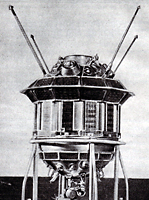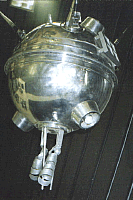On April 12, 1961, the Russians launched Vostok 1, the first spacecraft that would carry a human into space. This person was Yuri Gagarin. He made a 108 minute orbit around the Earth. When he dropped down from the spacecraft after reentry, he landed in a different spot from where he launched.
“The spacecraft consisted of a nearly spherical cabin covered with ablative material. There were three small portholes and external radio antennas. Radios, a life support system, instrumentation, and an ejection seat were contained in the manned cabin” (NASA.gov). The cabin itself also contained many other apparatus. While Gagarin was in orbit, the spacecraft itself was being manned from below. He maintained consistent communication with the stations below, and was able to calmly make a full orbit around the Earth. While above, he was able to view many changes in weather over the continents, as well as many features in the terrain.
 |
| http://www.sciencephotogallery.com/image/yuri_gagarin_onboard_vostok_1_4951777.jpg |
The Vostok was designed for Gagarin to be able safely eject and land on the ground with a parachute. When he reentered the atmosphere, he landed in Kazakhstan, south of Russia.
Gagarin’s successful orbit of the Earth would lead to new developments in space exploration as well as the launching of many more spacecraft that contained humans. Many saw this feat as groundbreaking, and the USSR was praised for having accomplished such an amazing task.



